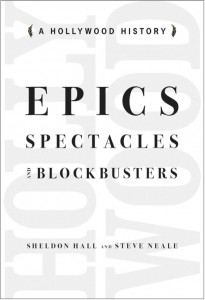Epics, Spectacles, and Blockbusters: A Hollywood History by Sheldon Hall and Steve Neale (Wayne State University Press, 2010). 363 pages. ISBN: 978-0814330081 (paperback), £31
 About the reviewer: Julian Stringer is Associate Professor in Film and Television Studies University of Nottingham and is currently researching the cultural politics of location filmmaking as well as several projects related to East Asian cinema. He is the editor of Defining Cult Movies: The Cultural Politics of Oppositional Taste (2003, Manchester University Press); Movie Blockbusters (2003, Routledge); with C-Y Shin, New Korean Cinema (2005, Edinburgh University Press); with A. Phillips, Japanese Cinema: Texts and Contexts (2007, Routledge); Wong Kar-Wai's 'In the Mood For Love' (Hong Kong UP, 2012).
About the reviewer: Julian Stringer is Associate Professor in Film and Television Studies University of Nottingham and is currently researching the cultural politics of location filmmaking as well as several projects related to East Asian cinema. He is the editor of Defining Cult Movies: The Cultural Politics of Oppositional Taste (2003, Manchester University Press); Movie Blockbusters (2003, Routledge); with C-Y Shin, New Korean Cinema (2005, Edinburgh University Press); with A. Phillips, Japanese Cinema: Texts and Contexts (2007, Routledge); Wong Kar-Wai's 'In the Mood For Love' (Hong Kong UP, 2012).
The study of Hollywood’s large-budget, large-scale, high-visibility movie juggernauts – what in contemporary parlance are currently called ‘blockbusters’ – is by now an accepted part of the Film Studies curriculum, a way of introducing students to concepts like the New Hollywood and Global Hollywood. However, consideration of the US film industry’s policy of engineering such products so as to foreground technological developments, showcase new aesthetic characteristics, upgrade exhibition arrangements and maximise profit potential is frequently neglected in scholarly investigations of ‘Old Hollywood’. This substantial monograph by two leading film historians provides students and researchers with a fresh approach to this important topic as well as a large amount of new information on one hundred years of American movie history.
 Across the book’s eleven painstakingly researched and closely argued chapters, Sheldon Hall and Steve Neale trace a century of high-end film production in the US. Their focus is multi-dimensional. Epics, Spectacles and Blockbusters summarises intensive research into aspects of production, distribution, exhibition, aesthetics and consumption, taking into consideration significant technological innovations such as sound, widescreen and digital. Innumerable films are discussed, ranging from familiar objects of academic scrutiny such as Gone with the Wind (1939) and Jaws (1975) to more critically overlooked examples of popular commercial filmmaking like A Midsummer Night’s Dream (1935) and Pearl Harbor (2001). The result is a pioneering and comprehensive account of a certain tendency in Hollywood cinema.
Across the book’s eleven painstakingly researched and closely argued chapters, Sheldon Hall and Steve Neale trace a century of high-end film production in the US. Their focus is multi-dimensional. Epics, Spectacles and Blockbusters summarises intensive research into aspects of production, distribution, exhibition, aesthetics and consumption, taking into consideration significant technological innovations such as sound, widescreen and digital. Innumerable films are discussed, ranging from familiar objects of academic scrutiny such as Gone with the Wind (1939) and Jaws (1975) to more critically overlooked examples of popular commercial filmmaking like A Midsummer Night’s Dream (1935) and Pearl Harbor (2001). The result is a pioneering and comprehensive account of a certain tendency in Hollywood cinema.
The authors’ chosen method is to tell this particular history through analysis of industry discourse found in the film trade press, especially Variety. The book’s strengths all grow out of this key decision. Hall and Neale’s empirically grounded approach yields original insights that allow new narratives of knowledge and understanding to be constructed. For example, paying close attention to the language through which Variety, among other sources, has discussed and described historical change provides a means of tracking the shifts in terminology associated with such developments. In turn, this way of proceeding promises to enhance comprehension of the inter-locking nature of Hollywood as a mature business practice by highlighting how and why aspects of production are contingent upon factors linked to distribution and exhibition. Close analysis of scenes from selected movies capture these developments through practical example and have obvious classroom application.
Given the extensive amount of research, as well as clarity of both thinking and expression, that has gone into the production of this major contribution to Film Studies and American History, it would be churlish to make finicky criticism of this or that particular aspect of its achievement. However, within the narrowly defined terms of reference the authors have set for themselves, the book could nevertheless have been strengthened in a couple of ways.
http://www.youtube.com/watch?v=LlzfqVtmxVA
Certainly, the reader is left craving more consideration of audiences and reception practices –the social dimensions of ‘blockbuster’ culture - to place alongside the multi-faceted treatment of the assembly, circulation and presentation of attention-grabbing movies. In addition, given the close relationship between the US trade press and the industry it ostensibly services and represents, greater consideration of the pros and cons of Variety as a primary source would have off-set the authors’ (over?) dependence on this specific publication. Finally, it is important to state that the increasingly complex story of Hollywood’s interrelationships with overseas companies, for example through co-productions, remains relatively neglected across these pages. While touching upon the subject in several key places, the authors state in their Conclusion that ‘foreign earnings were rarely recorded systematically in the industry’s press from the 1940s to the 1990s’ (p. 262) and that the scant regard shown by Variety to certain overseas markets produced ‘a highly selective impression of uninterrupted global growth’ (p. 308). Yet these important observations do not completely detract from the fact that Hall and Neale have less to say than might be expected about international markets and transnational cooperation in the post-1990s. The perfunctory feel of the book’s final chapter – wherein twenty three years (1986-2009) of ‘globalization’ are covered in a mere twenty four pages – suggests that the authors either ran out of steam or else do not consider themselves best placed to deliver a more finely nuanced overview of Global Hollywood.
http://www.youtube.com/watch?v=ZcuRaAi5MF0
To what extent does Epics, Spectacles and Blockbusters constitute a defence of Hollywood’s high-visibility movie juggernauts? Tentative justifications of the US film industry’s policies in this regard occasionally peek through, as in the reference to the ‘sheen of “quality” that generally went with a large budget’ (p. 91 – the word ‘quality’ is put in scare quotes though) or the statement that ‘the facility of even the widest screens for both spectacle and subtlety (sometimes simultaneously) can also be observed in blockbusters made by now-unfashionable craftsmen’ (p. 156). This is a book that, out of an admirable desire to construct new narratives of Hollywood history, plays down auteur-centred approaches to US cinema. Yet it stops short of validating the nature, purpose and practice of ‘blockbusters’ themselves. Hall and Neale have spent years researching a large and detailed work on a century of films made by thousands of faceless artisans for the edification of millions – surely such intellectual commitment itself ratifies the object of study. However, in a cultural context where such films are often still frowned upon, it might have been nice to have had this point articulated more boldly.
... it is ambitious and it fulfils its promise. It is a major scholarly accomplishment
Let us end by restating this book’s importance. The easiest thing in the world for a book reviewer to do is to suggest that the writer(s) under consideration could have done more. Indeed, this complaint may be taken to be one mark of a job well done - it indicates that the book has left the reader wanting more. Epics, Spectacles and Blockbusters is not the last word on the subject, but it is ambitious and it fulfils its promise. It is a major scholarly accomplishment.
Julian Stringer